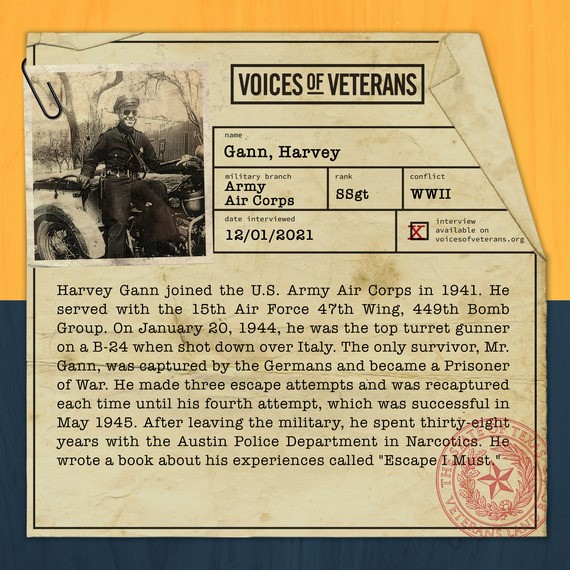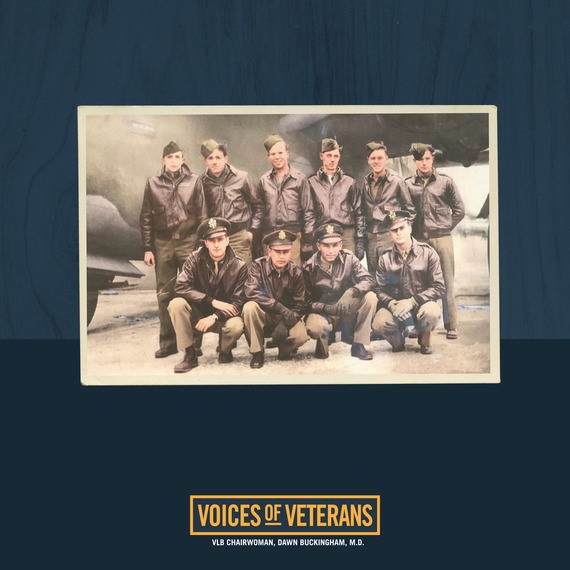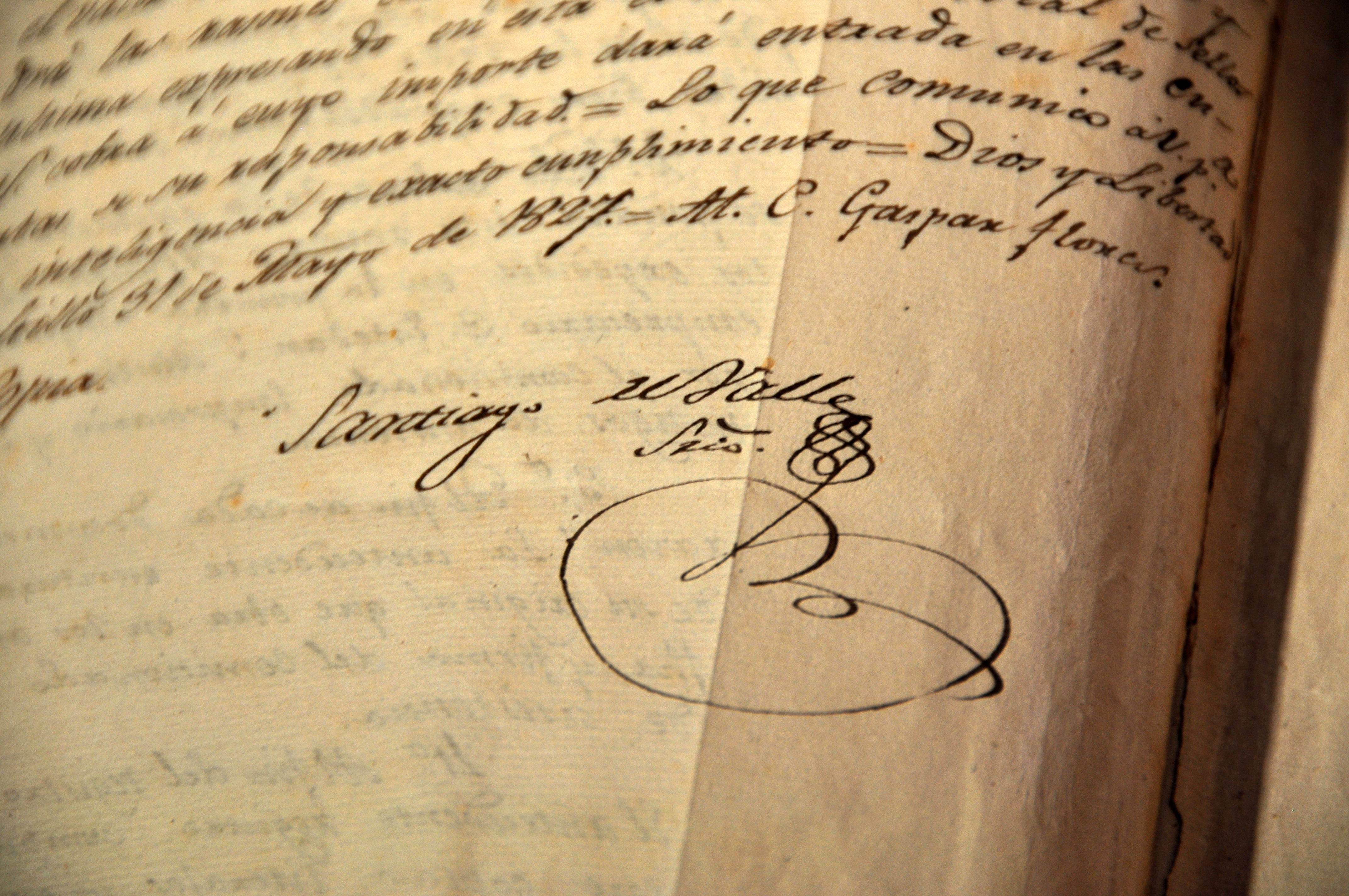Today, Texas Land Commissioner and Veterans Land Board (VLB) Chairwoman Dawn Buckingham, M.D., is proud to introduce the next installment of the series highlighting the VLB's Voices of Veterans oral history program. This week, we highlight the service of Staff Sergeant Harvey Gann, who served in the U.S. Army Air Corps.
Gann was born in Detroit, Michigan, in 1920. His brother served as a Captain in the Navy in the South Pacific, and his father served in WWI. Before the war, Gann worked to help build Bergstrom Air Force Base. He recalled that he was out in the front yard of the family home when he heard about Pearl Harbor being bombed.
He joined the Army Air Corps in 1942 and attended boot camp at Keesler Air Force Base in Biloxi, Mississippi. Later, he attended mechanics school in Detroit and aero-gunner school in Tucson, Arizona. He then went to Miami, Florida, where he shipped out to fight in World War II.

After arriving in Europe, he served in Italy with the 15th Air Force's 47th Wing, 449th Bomb Group. On January 20, 1944, he was the top turret gunner on a B-24 when it was shot down over Italy.
“I was shot down on my fourteenth mission. We had been bombing an airfield and oil refinery near Hungary […] at that time it was the biggest air-raid, about 500 planes all together. In my crew, there were three of us riding together, and we all got shot down simultaneously. The plane was on fire, and a German bomber was attacking us. One of them came straight in shooting and my turret was hit and blew the dome off of it. My head was bleeding, and my nose was bleeding, and I fell out of my top turret. The number two engine was on fire. I went to go get the pilot to tell him we better get out because I smelled gasoline. Of course, they were still shooting and hit the inside area and it blew up.”
The pilot and the co-pilot were in the bomb bay and Gann signaled to them he was about to jump. He said, “They were ready to jump when I got out of the way.” He leaped from the plane and deployed his parachute. Unfortunately, Gann was the only one to survive.
“I was on the way down and couldn’t hear anything for a few seconds. I turned around, and there were two German fighter planes coming toward me. I started wiggling my shoot from one side to the other and it popped a couple times. I knew I better quit that because I’d make a streamer out of it. So, I just hung there and figured, ‘Well, if you're gonna shoot me, go ahead.’ They didn’t. They gave me a highball and went on.”

He encountered German forces after landing and became a Prisoner of War (POW). They went to Germany, and Gann was put into Dulag Luft, a transition camp for newly captured aircrews. They put him and other POWs into cells for solitary confinement. After being interrogated by the Germans, Gann was assigned to an official POW camp where he recognized a ball turret gunner who was shot down before him.
“Of course, we had a lot of conversations about how we got where we were. I wasn’t there but a few days and we started talking about how we were gonna escape from here. While we were trying to figure out how we were gonna get away, two of the other guys wanted to go with us. We wound up escaping together on March 11th.”
Gann was given a stolen pair of wire cutters and cut the barbed wire fence during their escape. He got caught on the wire twice, and the second time he became ensnared, a guard was coming toward him. “I couldn’t get out without making a bunch of noise, so I had to just lay there, and I just knew I was a dead duck. I just curled up in the snow. All I could do was wait and dawg gon’ it, they walked on by and went on.”
He and the other men escaped the camp and were gone for seven days before they were recaptured. He made three escape attempts and was recaptured each time until his fourth attempt, which was successful in May 1945.
Gann reminisced about taking a ship back to the United States after the War ended. He talked about a party thrown on the boat in honor of the service members where they were treated like “kings,” and everyone wanted to buy a war hero a drink.
After the war, Gann didn’t have enough service time to be discharged. So, he did a tour with the Air Transport Command, where they stored and disassembled old war planes. He also got an opportunity to fly a B-29 as a flight engineer.
He met his wife, Evelyn, after he was discharged in 1945 while her sister stayed in one of the rooms in a boardinghouse run by Gann’s mother. Gann and Evelyn got married the next year, a fact Evelyn herself chimed in to provide, which earned a soft chuckle from her beloved husband.
When Gann began working for the Austin Police Department (APD), he was among the first group to be hired after the war and to attend school provided by the department. He worked with APD for thirty-eight years in the Narcotics Division. In 1996, Gann wrote his book, Escape I Must, about his time living in and escaping from POW camps in Germany.
When asked about the secret to his longevity and his philosophy on life, Gann laughed warmly saying, "Be positive and not only positive, be optimistic, I think. You’ve gotta be a real force to make one hundred.”
To listen to Staff Sergeant Harvey Gann tell his story, click the button below:
Staff Sergeant Harvey Gann's Story
RELATED: Voices of Veterans: Voices of Veterans: Lt. Eldon Bielss Shares His Story of Service in the U.S. Army, Air Corps During WWII
RELATED: Voices of Veterans: Voices of Veterans: Private First Class Buster Lee Bailey Shares His Story of Service in the U.S. Army Air Force
Voices of Veterans is a state agency's first Veteran oral history program. It records the stories of Texas Veterans through their time in service and after returning home from combat.
The VLB records interviews with Veterans over the phone or in person. Their interviews are then permanently archived in the Office of Veterans Records at the GLO, where they join the historical documents of other Texas heroes such as Sam Houston, Davy Crockett, Jim Bowie, and William Barret Travis.
Veterans' interviews are also available to researchers, historians, genealogists, and the public. These precious records inspire future generations and remind us of our Veterans' sacrifices.
To listen to the over 500 archived stories of Veterans documented through the GLO's Voices of Veterans oral history program, click the button below:









